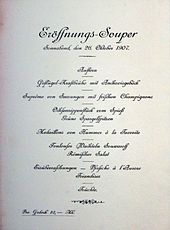Menu (sequence of dishes)
In gastronomy, a menu ( borrowed from the French menu for 'small', 'little thing' in the 19th century ) is a combination of dishes and dishes that consists of several courses. One still speaks today of a course (hist. Costume ), because the servant had to make a new course every time to bring the new dish into a menu.
history

The classic menu is a sensible combination of dishes. It starts with light "bites" ( amuse-gueule or mise en bouche ) that introduce the menu. For this purpose, if appropriate, be appetizers served. Then starters or soup follow. More substantial dishes, i.e. meat and fish dishes, make up the main part of the menu. Sorbets have a fresh and neutralizing effect; they are sometimes served between courses in order to briefly interrupt a menu or to distinguish strong taste differences. This gives the guest time to prepare for the next course. Finally, you can end the menu with small, relatively light dishes.
The modern menu is structured similarly to the classic menu. Light dishes open up the meal, usually a cold and / or warm starter and a soup are served. The main course is the highlight and lighter dishes round off the menu.
Compilation


A menu is by no means an arbitrary sequence of dishes. There are important rules that every cook must master. This concerns, among other things, the avoidance of repetitions of the raw materials in the sequence of dishes, but also the method of preparation. Furthermore, light raw materials are followed by dark ones in the next aisle; Bound dishes are followed by unbound (clear) etc. In the end, all dishes should result in a harmonious interplay.
Menus can be put under a motto, such as B. “From the sea” ( fish and seafood , seaweed ) or “From the forest” ( game , mushrooms , chestnuts , berries , etc.). A menu should be adapted to the group of guests: Participants in a conference who mainly work mentally have e.g. B. very different expectations of a menu than a wedding party.
The naming of a dish follows a certain pattern: main ingredients and how they are prepared (possibly with a garnish ), sauce, vegetables, side dish and salad. The individual elements are connected to one another by prepositions .
Classic and modern menu in comparison:
The classic menu
|
The modern menu:
|
Note: There is no agreement on the question of whether the cheese course is served before or after the sweet dessert. If, for example, a heavy red wine is drunk with the main course, the cheese follows and not the dessert (which is usually served with sweet wine, sparkling wine, champagne or dessert wine). In this way, the harmony of the corresponding drinks is preserved.
Note: Another difference between the classic menu and the modern one: With the classic menu, the starters (French: hors d'œuvre = "outside the factory") and the soup were not served at the table, but in a different room beforehand. Thus, the entrées (French for “entrance, beginning”) are actually the first dishes on the table. The desserts are called entremets (French: "intermediate course") because they were served between artistic interludes (music, song, dance).
Special forms
In kitchens from non-European cultures, the menu can be completely different. In China, for example, several dishes are served at the same time and a soup is served at the end. Desserts are unknown there, but sweet dishes are often served with the other dishes.
Different word meaning
After the menu cards with the menu, the term is sometimes used as a term for the general menu of a restaurant .
Confusion in North America
In the USA, entrée usually refers to the main course.
Web links
literature
- Eugen Pauli: Textbook of the kitchen. Orell Fuessli Verlag, Aarau 1984, p. 215.
Individual evidence
- ↑ hotelfach.de - menu customer . Retrieved July 15, 2012.
